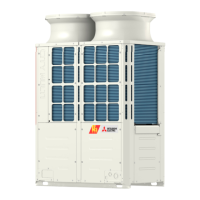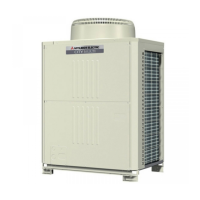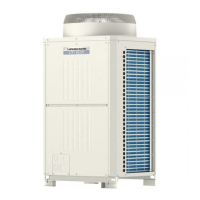
Do you have a question about the Mitsubishi Electric PURY-P120 and is the answer not in the manual?
| Brand | Mitsubishi Electric |
|---|---|
| Model | PURY-P120 |
| Category | Air Conditioner |
| Language | English |
General safety rules and warnings for unit installation and operation.
Specific guidelines for handling R410A refrigerant and related tools.
Initial checks and safety precautions before system servicing.
Lists essential tools and materials for installation and servicing.
Details specifications and types of copper pipes for R410A systems.
Guidelines for proper indoor storage and sealing of refrigerant pipes.
Instructions on using ester oil for flares and flanges, and minimum oil usage.
Procedures and precautions for brazing refrigerant piping, emphasizing non-oxidized solder.
Method for conducting air tightness tests using nitrogen and leak detectors.
Steps for achieving proper vacuum degree and time for evacuation.
Guidelines for charging R410A refrigerant in liquid phase.
Procedures for replenishing refrigerant after a leak.
Comparison of R410A with conventional refrigerants regarding properties and pressure.
Information on HFC refrigerants, oils, and effects of contaminants.
Table summarizing compatible indoor units with different outdoor units.
Guidelines for electrical wiring, including cable types and maximum lengths.
Instructions for setting switches and addresses for various system components.
Illustrative examples of typical system connections for MA and ME remote controllers.
Wiring and cautions for systems with one outdoor unit and MA remote controller.
Wiring diagrams and cautions for systems with one outdoor unit and ME remote controller.
Wiring examples and cautions for systems using both MA and ME remote controllers.
Details on allowable pipe lengths and height differences for various system configurations.
Front views and refrigerant circuit diagrams for different outdoor unit models.
Identification of components within the outdoor unit's control box.
Diagrams showing connectors and components on the outdoor unit's main circuit boards.
Identification of components for BC controllers (G, GA, HA, GB, HB types).
Illustration of the control box for BC controllers, showing transformers and boards.
Diagrams of the BC controller circuit board, highlighting switches and connectors.
Comparison of features and specifications between MA and ME remote controllers.
Procedures for group settings and interlock configurations using the ME remote controller.
Steps for setting up LOSSNAY interlocks with indoor units using the MA remote controller.
Instructions for selecting temperature detection sources, including built-in sensors.
Detailed wiring diagrams for PURY-P72TJMU-A and other models.
Wiring diagrams for BC controller models CMB-P104NU-G, CMB-P105,106NU-G, and CMB-P108,1010NU-G.
Wiring diagram for the transmission booster.
Schematic diagrams of refrigerant circuits for various outdoor unit models.
Explanation of the functions and specifications of key components in the refrigerant circuit.
Details on dipswitch functions for outdoor unit control boards and INV boards.
Explanation of control methods, startup sequences, and operation modes.
Details on controlling solenoid valves (SV) and expansion valves (LEV) for BC controllers.
Flowcharts illustrating mode determination for indoor units and outdoor units.
Pre-test run checks including refrigerant leaks, wiring, and insulation resistance.
Step-by-step instructions for performing a test run using the MA remote controller.
Understanding refrigerant characteristics and operating parameters for adjustment.
Symptoms of overcharging/undercharging and how to adjust refrigerant.
Procedures for entering and operating the refrigerant amount adjustment mode.
Common normal operating symptoms that may appear during or after operation.
Tables of standard operating data for various models in cooling and heating modes.
Comprehensive list of error codes, their definitions, and searched units.
Guidance on interpreting and responding to error codes displayed on the remote controller.
Methods for checking transmission line wave patterns and identifying noise interference.
Detailed troubleshooting steps for key components like pressure sensors and solenoid valves.
Procedures for identifying and repairing refrigerant leaks in various scenarios.
Step-by{47}step guide for safely removing and replacing compressor components.
Procedures for servicing the BC controller, including control box and component checks.
Guide to interpreting LED error displays on the outdoor unit for diagnosing issues.











